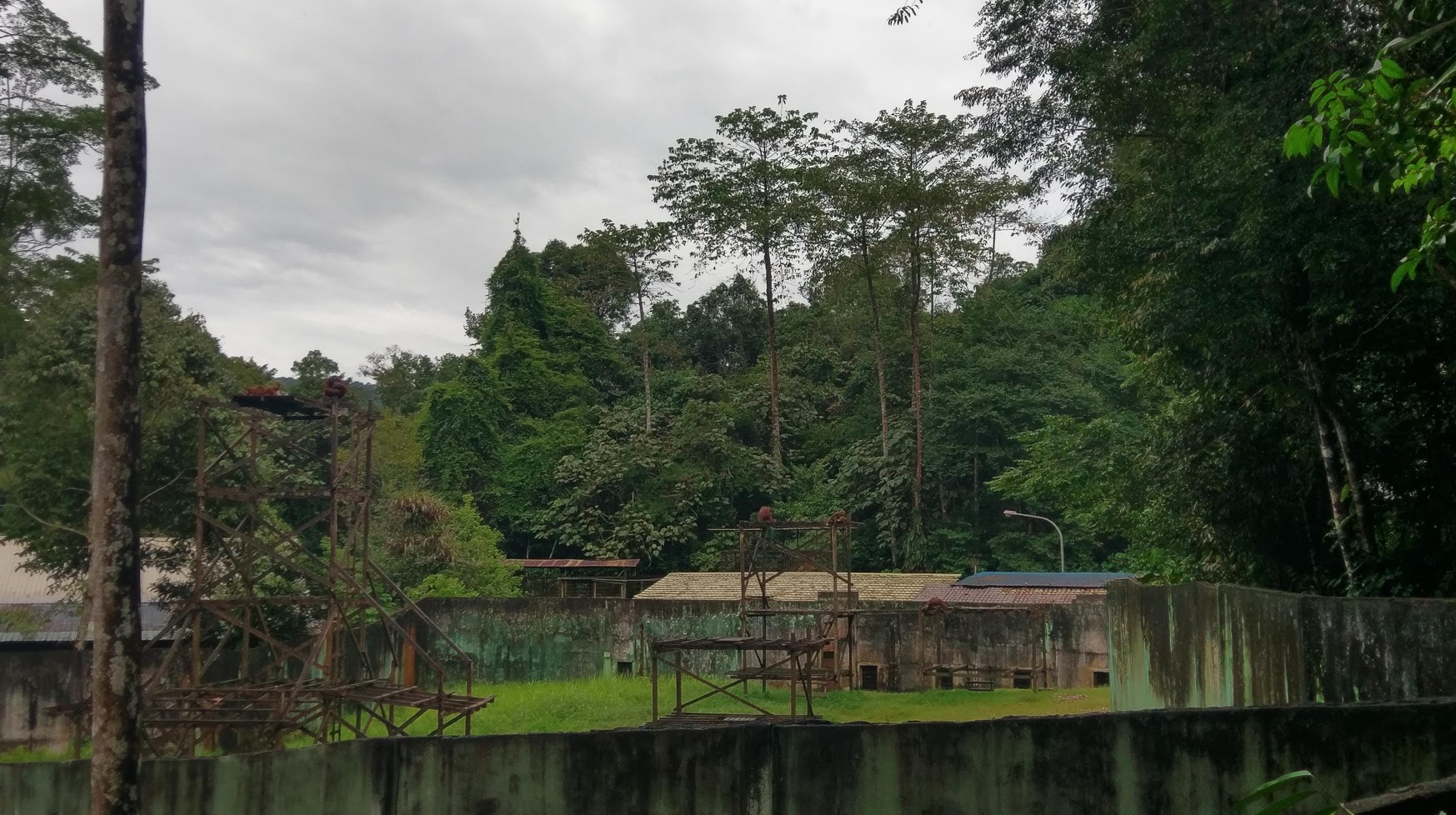Orangutan
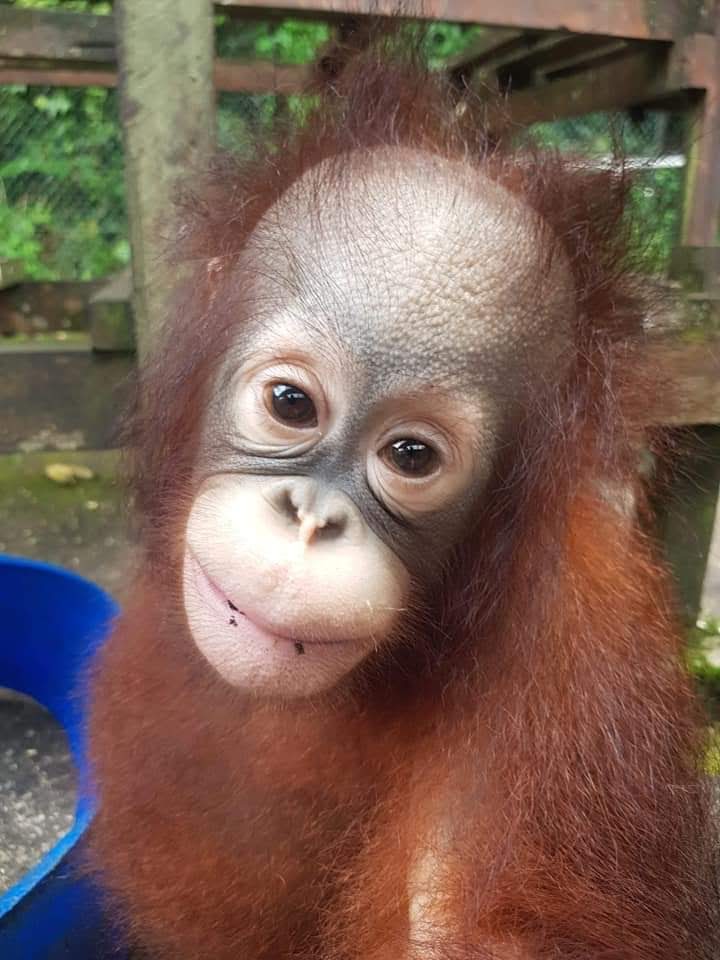
A bit about them
A big bundle of bright orange fur in a stark contrast of lush green rainforest...
The orangutan is one the the smartest animals alive, very closely related to humans and a master of mischief.
So why are they critically endangered?
Common Name
Orangutan
Translated to 'Person of the forest' in Malay.
Closely related to/Family tree:
Orangutan are 1 of 5 members of the exclusive group known as the Great Apes.
The other members are: Chimpanzees, Bonobos, Gorillas and Humans.
The Great Apes are all from the family Hominidae and are considered Great apes for their large size and weight as well as their tendency towards higher intelligence.
Kingdom:
Animalia
Phylum:
Chordata
Class:
Mammalia
Order:
Primates
Family:
Hominidae
Genus:
Pongo
Species:
X
There are three
species of Orangutan, the most recent of which was only released in 2017.
The
three species are:
- Pongo Pygmaeus (Bornean Orangutan)
- Pongo Abelii (Sumatran Orangutan)
- Pongo Tapanuliensis (Tapanulia Orangutan)
Appearance:
Orangutan are very distinct apes, their most defining feature being their bright orange fur that covers most of their body.
With the average adult Orangutan being around 1m tall and weighing 50-100kg, they tend to stand out in their jungle locals.
A dominant male exceeds these averages and can be 1.5m tall and weigh up to 30kg!
This is because he wants to demonstrate his strength in size which is also aided by the addition of facial flanges. Large pads of adipose tissue (Fat) alongside the face amplify his calls like a megaphone and create a little Je ne sais quoi for the ladies.
Non-dominant males
however tend to look quite similar to their female counterparts and won't
develop into a dominant male until there is no presence of a dominant male. A
male Orangutan can go it's whole life without becoming dominant.
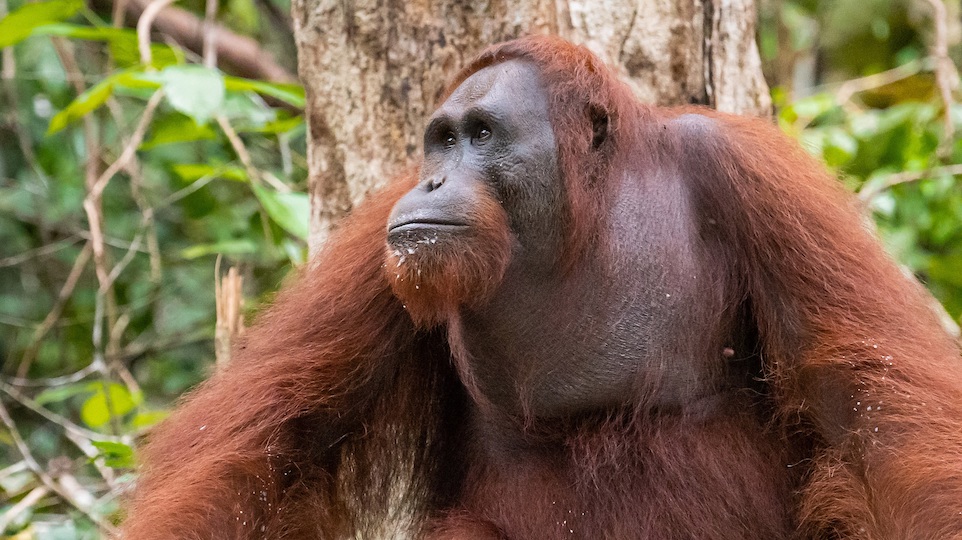
When standing on the
ground, and Orangutans hands will reach its ankles, as their arms are far
longer than their legs. A dominant male may have arms longer than his whole
body. This makes it much easier for them to climb and swing through the jungle
canopy.
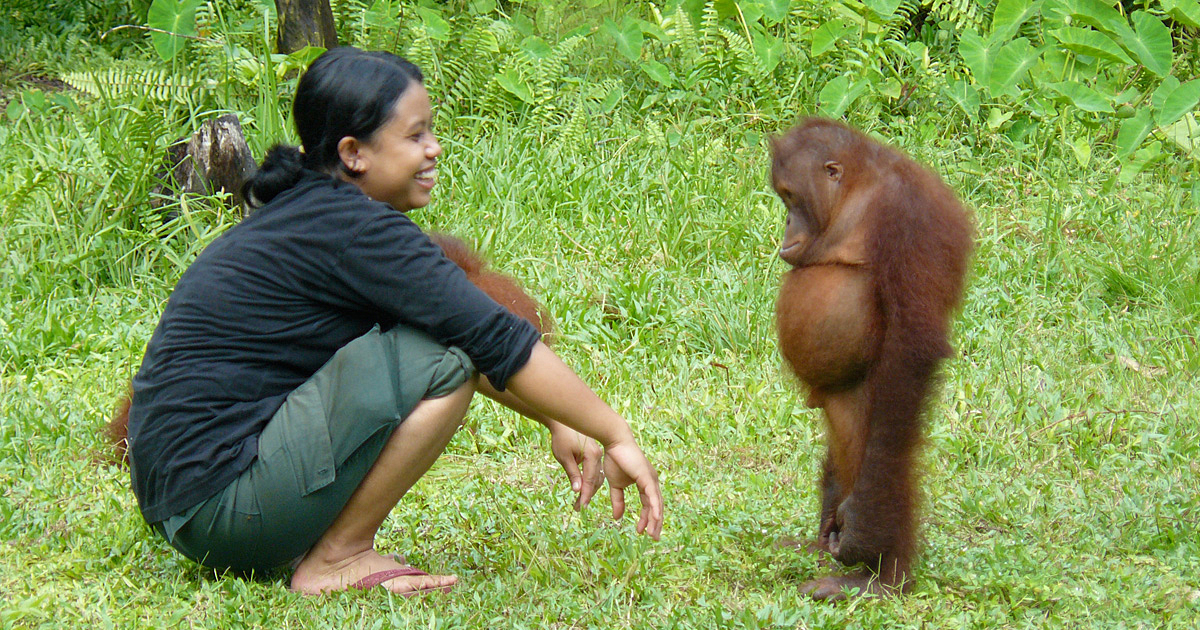
Their hands and feet look almost identical and both have opposable thumbs, again, making it much easier to climb trees.
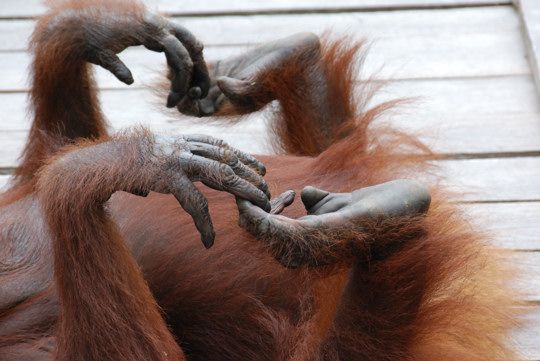
A group is called:
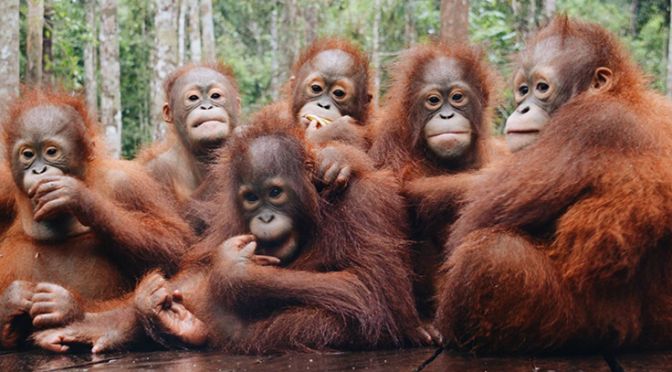
Status:
History:
Orangutan begin their historic journey as most large animals do when living alongside humans; In Folklore.
Throughout all of the stories however, they are always considered to be close to human in one way or another and always respected, through fear, honour or admiration.
In the 17th century, the West first discovered Orangutans and then throughout the 19th century as Western explorers ventured throughout SE Asia the population of orangutan began its decline. Explorers hunted Orangutan relentlessly and more and more zoos demanded Orangutan be in their exhibits. They were made to perform tricks and actions which were not at all natural to Orangutan. Since the 1940's, such tricks have been banned and from the 1960's onwards, there has been much focus on teaching Orangutan skills they would use in the wild. Such as climbing, nest making and puzzles.
Range:
Habitat:
Tropical rainforests are the main habitats for all species of Orangutan, but drier forests can also be inhabited. They prefer sections of forests close to freshwater sources.
Habits/behaviours/intelligence:
An odd habit for such incredibly smart beings.
1. Tool use
There are many cool stories of Orangutans using tools for various purposes. Some of which include:
Using sticks to dig out bugs
Commonly seen among
most of the great apes, sticks are used to reach into small and deep crevices.
They can help reach inside ant or termite colonies which otherwise would be
unreachable.
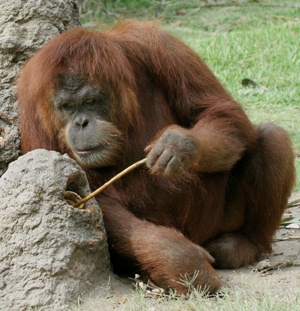
Using leaves to make some calls louder
The squeak noise
used to display irritation is sometimes amplified by orangutan by folding a
leaf between their lips. This either makes them seem larger to those who can't
see the orangutan making the call, or it can show an increased level of
annoyance.
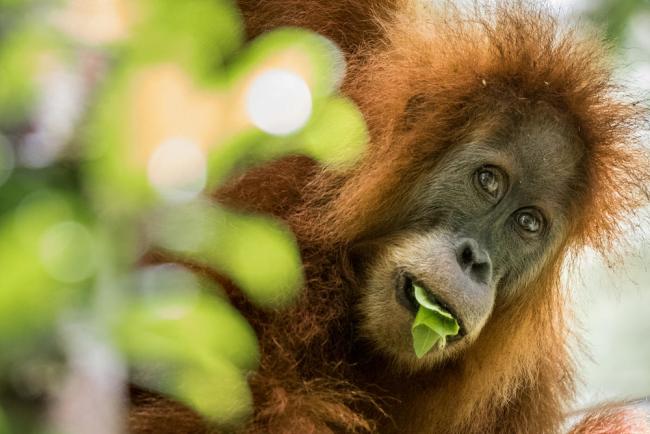
Using leaves and material as umbrellas or jackets
Living and sleeping in a rainforest habitat has many challenges, but keeping dry is probably the most common one. So Orangutan have solved that issue with tools.
Even mimicry of human tools
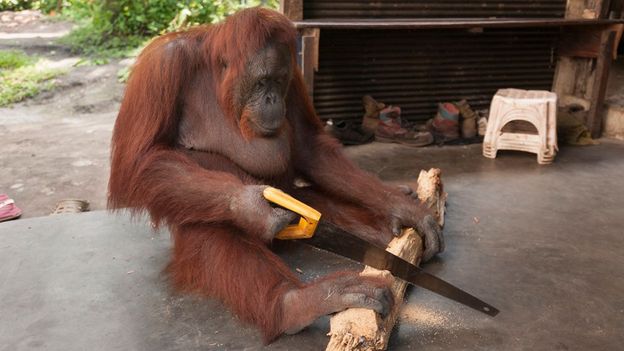
While orangutan don't 'talk' like Humans do because they don't have much need for verbal communication, they do have a language of sorts.
The most common is a 'Long call' which can last for a minute. This signifies presence. This is a loud call which lets other orangutan that are close enough to hear it that there are others nearby. In dominant males it can also be a mating call. It has also been speculated that this 'long call' is used a courtesy warning to others that a storm is approaching. Giving everyone enough time to make their beds and shelters.
They also make squeaking or kissing sounds when they are annoyed or irritated.
If you find an orangutan blowing 'raspberries' at you, tapping you on your side or giving a little bite, then it is more than likely that they are simply asking you to play.
Non-verbal communication is the main game for Orangutan. They use a lot of body gestures and facial expressions to convey meaning. They have even been taught sign language on several occasions. Researchers have shown what's known to be Orangutan Charades. When making a gesture for something, if they're message isn't understood, they will try to convey it in another way, or simply keep repeating the same gesture over and over, because the other person just simply isn't getting it!
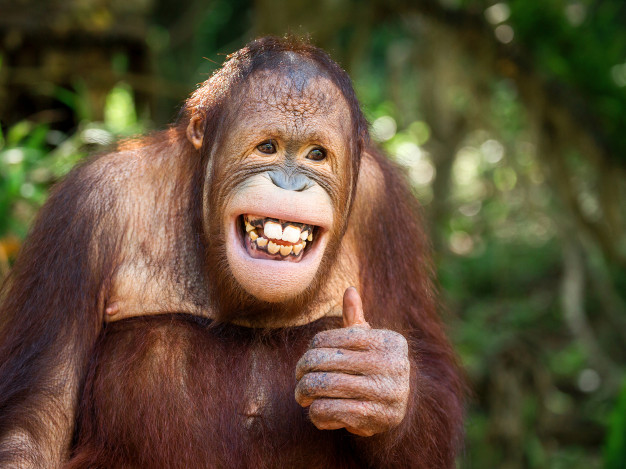
A common test for self-awareness in animals is to place a dot on their face (Either with a marker or a sticker) and then give them a mirror. If the animal inspects the dot on their face and or tries to remove it, then it shows that they recognise the animal in the reflection as themselves and not another being. Orangutan have been shown to pass this test.
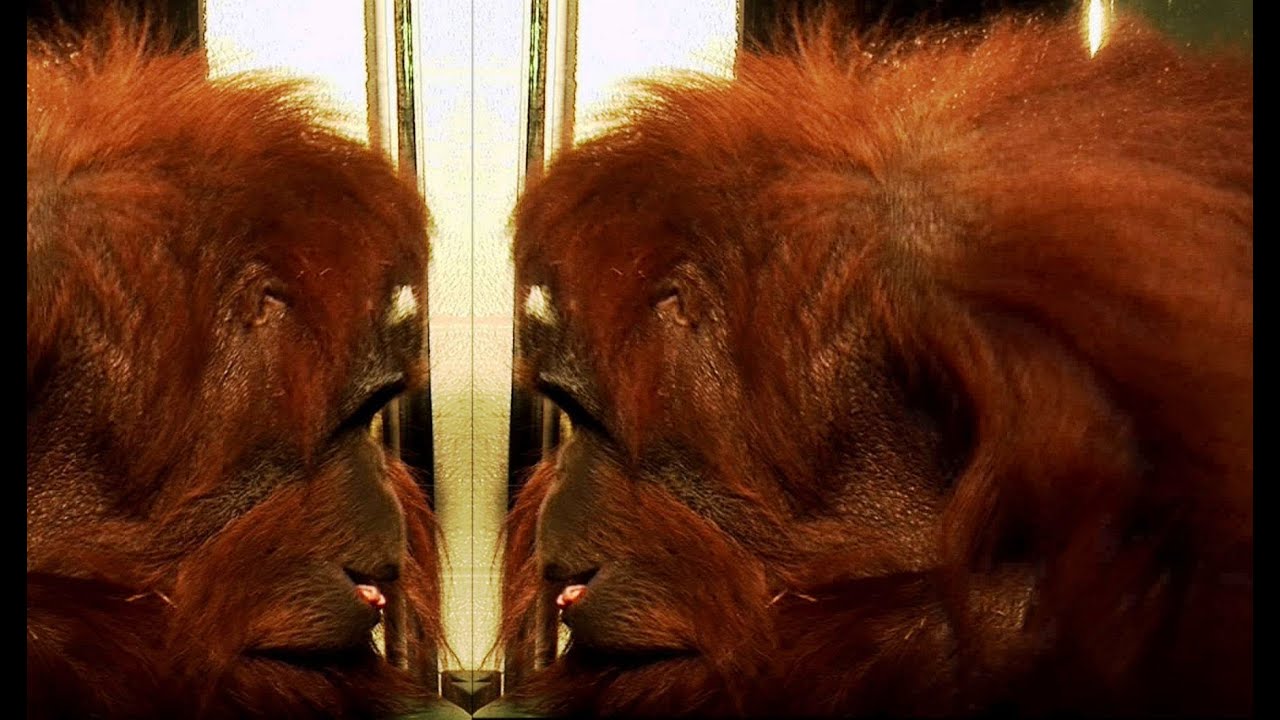
Atlanta Zoo even has touch screen for their Orangutan to play games on!
Feeding style:
These guys love a fruit salad, coupled with South East Asia's finest tree hollow, still water.
Eating what's in season and in plenty of supply, they will choose from a selection of Mangosteen, Durian, fig, lychees and drupes. Anything with a nice soft pulp around the seed. This classifies them mostly as frugivores, however they aren't opposed to a side of leaves and soil to supplement their meal.
Because they eat so much fruit and cover such a large area of rain forest, they are avid green thumbs and are really good seed dispersers (Through their faeces). They are even credited with being the sole dispersers of some plant species.
Nesting/mating:
Not only are these guys inadvertent gardeners, but they are also avid builders. Each day they will build their own nest out of leaves and branches high up in the treetops. They have even been documented to form a roof of sorts when it's raining. These nests are often only stable enough for one time use and quickly fall into debris on the jungle floor the next day.
Orangutan have the longest inter birth period of any animal, making them very vulnerable to extinction from climate change, poaching and general population decrease.
With a gestation period of 8-9 months, Orangutan pregnancy is pretty standard. After which the baby stays with mum for the next 5-8 years. Clinging to her fur and slowly learning the intricate skills and details of Orangutan life.After the first few months, the baby slowly starts trying things for itself, developing its skills and interacting with its surroundings. The female won't have another child (Even actively avoiding males) until her current child is completely independent.
Females won't start having offspring until their mid teens and generally have just the 1 at a time (Twins are very rare).
Dominant male Orangutan are the clear best choice for females. They exude good gene potential and come with added bodyguard duties for the few days that they copulate. Because Orangutan territories are so vast, the best way to find another Orangutan is to just call out.
The non-dominant males don't have much luck with the ladies and will often resort to non-consensual mating. This can occur over a lot of fighting and resistance from the females, unless they aren't in oestrus. In which case the females generally don't care as there is very little chance of them being impregnated.
Cool facts:
Orangutan are said
to be the smartest animals after Humans (Well... some of us). Compared to the
intelligence of a 6 year old.
They are the world's
largest arboreal mammal and are the only great ape in Asia.
Orangutan who have
grown up in close quarters with humans may develop sexually tendencies towards
humans. A very serious issue, particularly in males, as non-consensual mating
is commonplace for non-dominant males and if not careful, incidences of sexual
assault can and have occurred.
If an Orangutan makes 'kissing' noises, it is likely that they are annoyed at something.
Predators/threats:
All Orangutan species are Critically endangered, but like all great ape species (Besides Humans), their only real threat.... Is Humans.
Habitat destruction is the leading cause of extinction in orangutan (And other species) throughout Indonesia and Malaysia.
Through illegal logging, fires (sometimes deliberately lit) and forest clearing for Palm oil plantations, the home of the Orangutan and countless other species is very quickly shrinking.
Over the last 20 years more than 3.5 Million Hectares of Malaysian and Indonesian forest have been destroyed for Palm Oil plantations. This is a severe issue for Orangutans as they like to live very solitary lives and the range of one single Orangutan is enormous. Females have a smaller territory at around 9km squared, while males can have a territory of around 25km squared!
As the forest
shrinks, Orangutans are forced more and more to travel and or live in farming
properties or small towns. This is quickly met with aggression from farmers and
locals as they can easily destroy and eat crops. Farmers are very quick to
reach for the gun when Orangutan are on their farms. Some will even go hunting
specifically for Orangutan as a pre-emptive method.
Females are hunted more than males as they are less aggressive and intimidating. If females have a child with them when shot, the child is often kept as a pet or sold to the illegal pet trade (Another major threat for orangutans).
More and more
orangutan are ending up in captivity for life, either because they were raised
by humans and have no chance surviving on their own in the wild, or because
there simply isn't enough room for them. A healthy Orangutan who is raised
among other Orangutan may be perfectly fine to be released, aside from there
not being enough space. If there isn't enough room when and Orangutan gets
released, they are likely to end up back in captivity because they've been
injured or captured again by farmers.
Conservation:
Palm oil companies are being managed to set aside conservation areas for
Orangutan, and national parks and safe zones are becoming more and more common
throughout Indonesia and Malaysia.
One method for the average person to help is to stop buying foods with palm oil
in them. This was initially a struggle as more than half of the foods available
in grocery stores contained palm oil. The options these days are much better
and making the conscious choice to avoid palm oil is a major help.
Some may argue that if palm oil stops bringing in profit, throughout Asia, then their fields of Palm crops will just be replaced with another type of crop, not solving anything. Further research and thought is needed to help solve this issue so that the animals and people of Malaysia and Indonesia come out on top.
In the mean time, you can help support some of these organisations through donations at the following sites:
Adopt an injured or ill Orangutan to help them return to the jungle:
https://www.orangutan.org.au/all-adoptees/
https://adopt.orangutan.com/adopt/
Or Donate for reforestation and general conservation support:
https://orangutan.org/donate/
https://orangutan.org/campaigns/orangutan-legacy-forest/
https://www.orangutan.org.au/donate/
References:
https://www.worldwildlife.org/species/orangutan
https://en.wikipedia.org/wiki/Ape
https://en.wikipedia.org/wiki/Hominidae
https://en.wikipedia.org/wiki/Orangutan
https://www.researchgate.net/publication/226112409_Orangutan_Home_Range_Size_and_Its_Determinants_in_a_Sumatran_Swamp_Forest
https://www.pbs.org/wnet/nature/blog/orangutan-fact-sheet/
https://www.inverse.com/article/9103-how-smart-is-an-orangutan-exactly
https://orangutancanada.ca/about-orangutans/intelligence/
https://www.balisafarimarinepark.com/orangutans-communicate/#:~:text=To%20communicate%2C%20orangutans%20employ%20both,which%20delivers%20the%20most%20message.
https://coconuts.co/jakarta/features/tales-forest-people-local-legends-protect-orangutans-way-environmental-regulations-cannot/
https://www.earthstoriez.com/myths-and-legends-of-the-orang-utan-indonesia/

